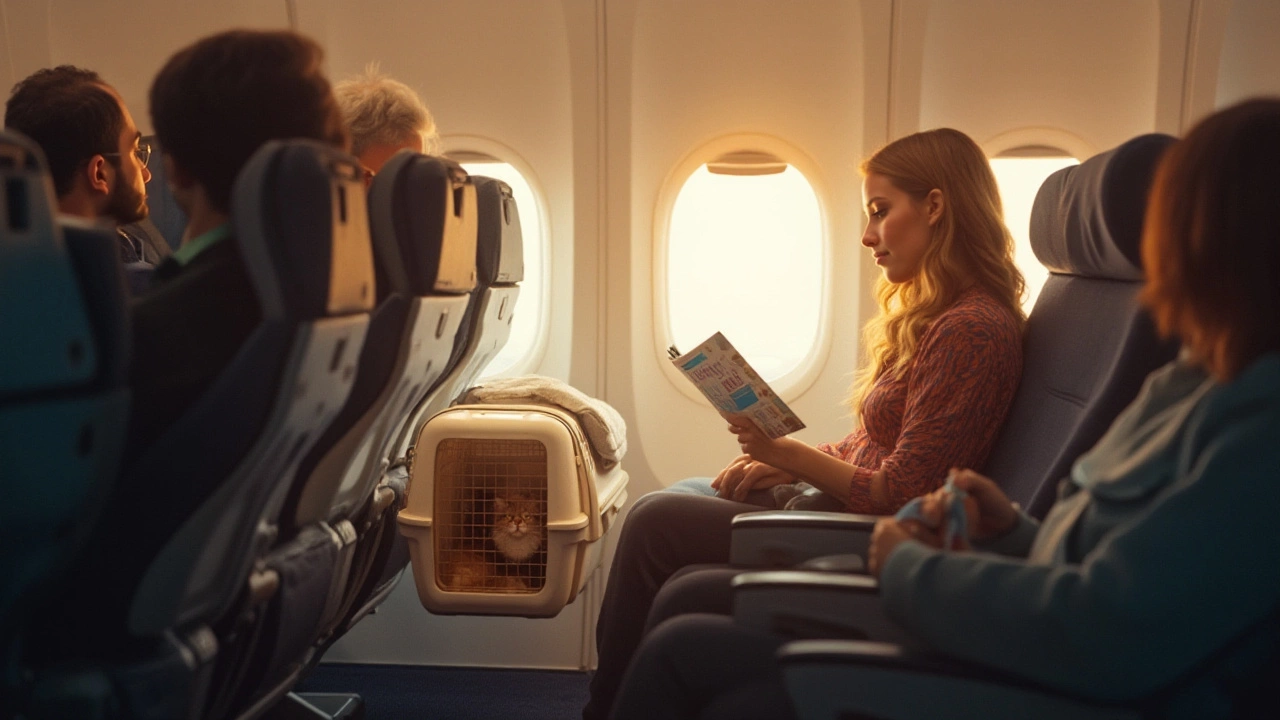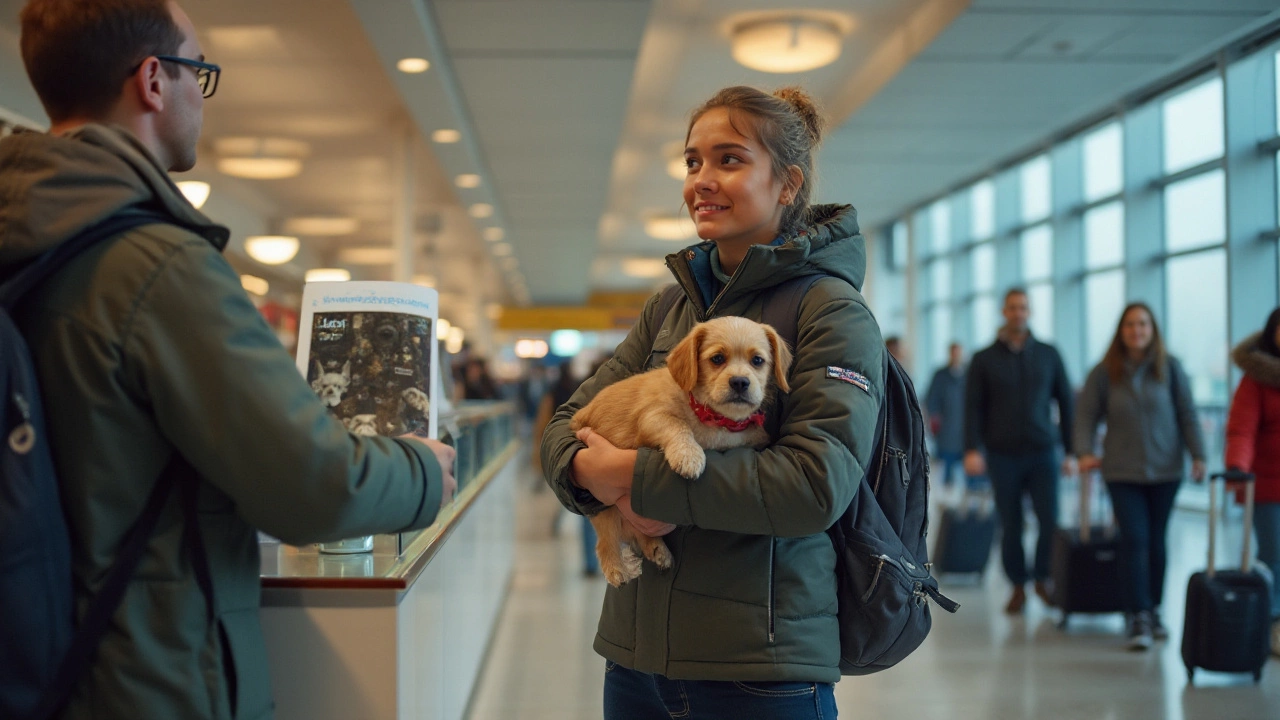Traveling with pets by air can be an adventure filled with as many joys as challenges. It's not just about booking a ticket and packing a suitcase; there's a furry friend to consider, too. If you're a pet owner, the mere thought of flying with your animal companion might bring up more questions than answers.
From understanding the unique policies of various airlines to ensuring that your pet's travel checklist is complete, navigating the world of pet travel requires preparation and patience. A little knowledge and planning can go a long way in making sure your pet stays happy and safe during the entire journey. Let's delve into the essential tips and useful information for a smoother flying experience with your pet.
- Understanding Airline Policies
- Preparing Your Pet for Travel
- In-Flight Care and Safety
- Post-Flight Considerations
Understanding Airline Policies
When it comes to flying with pets, knowing the specific regulations and policies of each airline is crucial. Airlines often have distinct requirements regarding the size and breed of pets allowed, as well as how they should be transported, whether in the cabin or cargo hold. Some airlines welcome a wide variety of pet types, while others are more restrictive. It's essential to check with your chosen airline well in advance to ensure compliance with their rules. Although many airlines allow small pets in the cabin, they typically need to be in a suitable carrier that fits under the seat. Larger animals often have to travel as cargo, which brings different considerations for the pet's safety and comfort.
The International Air Transport Association's Live Animals Regulations (LAR) are the global standard for transporting live animals by air. They specify the requirements for the safety and care of animals in transit. Following these guidelines helps to ensure a safe and comfortable journey for your pet.
It is worth noting that some breeds, especially short-nosed dogs and cats, face additional restrictions due to potential breathing issues during flights. Additionally, as comfort animals have become more prevalent, policies surrounding emotional support and service animals also vary. Drawing attention to documentation, vaccinations, and health certificates is another crucial aspect of preparing to fly with a pet. It's advised to have thorough documentation ready before reaching the airport, as airlines can ask for proof of your pet's health and vaccination records. Such preparations contribute significantly to a smooth security process and prevent last-minute surprises.
Research and Planning
Another essential aspect to consider is the booking process. Many airlines only allow a limited number of pets on each flight, making it imperative to book your pet's spot as soon as possible. This practice is usually on a first-come-first-served basis. Fees also vary greatly, so understanding the cost implications is vital. These may differ between domestic and international flights, with additional charges for layovers where pets might need special care. Pet travel policies can change, so stay informed by checking for updates from trusted airline sources or consultation with travel agents who specialize in pet-friendly airlines.
Preparing for the Journey
To ease the travel experience for both you and your pet, consider doing a trial run of the process. This can include visiting the airport with your pet, allowing them to become familiar with sight and sounds. Also, remember each country's specific entry requirements if you're crossing borders. These might require additional vaccinations or paperwork arranged months ahead. By dedicating time to research and planning, you set a strong foundation for a stress-free travel experience, ensuring both you and your pet are prepared for the flight.

Preparing Your Pet for Travel
Before embarking on a journey with your beloved pet, it is crucial to ensure that they are ready for the flight. Pets, much like us, experience stress and anxiety, especially when faced with the unknown environment of airports and airplanes. One way to ease this tension is through gradual acclimatization to travel conditions. Start by introducing your pet to their travel carrier well before the flight. Let them sniff, explore, and even nap inside it in the comfort of home. This familiarity can help mitigate any fear they might have about confinement during the flight.
Visiting the veterinarian is another essential step in preparing your pet for air travel. A health certificate issued by your vet within ten days of your flight is often required by airlines. During the visit, discuss any concerns you might have, including their diet and any necessary vaccinations or medications. Some veterinarians might recommend mild sedatives for particularly anxious animals, but this is a decision that should not be taken lightly or without professional advice. Remember, the health and comfort of your pet are paramount.
Diet plays a vital role in your pet's in-flight comfort. It's wise to feed them a light meal a few hours before departure to avoid any digestive mishaps mid-flight. Hydration is equally critical; keep your pet's water intake steady before the flight but be mindful of not overhydrating, as this might lead to frequent bathroom needs. If your pet is prone to motion sickness, try adjusting their feeding schedule and consult your vet for the best solution.
"Flying with pets requires more preparation than one might initially expect. It's essential to think of their comfort from start to finish," notes Jane Curtis, an expert in pet travel logistics.
To further enhance your pet's flying experience, consider investing in calming aids like pheromone sprays or comfort toys. These can provide reassurance during the flight and act as a reminder of home. Ensuring their carrier is equipped with familiar blankets or toys can give your pet a sense of security. Additionally, exercise your pet before heading to the airport. A tired pet is often a calmer pet, making the flight hopefully more peaceful for both of you.
If your pet is particularly nervous about the journey, a practice run can be beneficial. Short car rides in their carrier, visiting crowded places, or exposure to airport-like sounds can desensitize them gradually. Consistent positive reinforcement during these experiences will help tailor their behavioral response towards travel. Remember, preparation isn't just about physical readiness; it's also about emotional support.
| Key Preparation Steps | Details |
|---|---|
| Acclimatization | Introduce carrier early, practice confinement at home |
| Veterinary Check | Health certificate, discuss anxiety solutions |
| Feeding Strategy | Light meal pre-flight, manage water intake |
| Calming Aids | Pheromone sprays, toys, familiar items |
| Practice Runs | Short trips, exposure to travel sounds |

In-Flight Care and Safety
Ensuring your pet's safety and comfort during a flight can feel overwhelming, but with the right steps, you can make it a seamless experience. Let's start with the kennel or carrier, the primary safety measure during air travel. The carrier should be spacious enough for your pet to stand, turn around, and lie down comfortably, and it must meet the airline's regulations. Ventilation is crucial; make sure that it has sufficient openings for air flow. Some airlines may require specific types of carriers, often made from hard-shell plastic because they offer more protection. Remember to secure the door well to prevent any escape attempts by your adventurous pet.
Pet travel doesn't only involve sitting through a flight; it's a holistic experience. Consider using a comfortable blanket or a familiar toy inside the carrier to offer a sense of security. These familiar items help mitigate stress and anxiety that pets sometimes face in new environments. It's like offering a piece of home to cling to during a rather unfamiliar journey. During the flight, check on your pet periodically without opening the carrier. A simple glance or whisper can reassure them of your presence. Hydration is vital, especially for trips longer than a few hours. A collapsible water dish attached to the door of the carrier can be a lifesaver.
One interesting thing to note is the effect of cabin pressure on pets. Like humans, pets can experience discomfort due to changes in altitude. Their ears pop too! While there's little to be done during takeoff and landing, helping them relax throughout the flight and keeping their ears distracted with quiet games or talking gently to them can be soothing. Airlines may also allow you to visit the pet during layovers, which can be beneficial, especially for longer journeys. Flying with pets is about finding moments of calm amidst the chaos.
Some pet enthusiasts and organizations dedicate themselves to the cause of pet comfort. According to Pet Friendly Travel, noise-cancelling headphones specifically designed for pets are becoming increasingly popular. These innovative gadgets can significantly reduce the unfamiliar noises that may cause your pet stress.
“Flying with your pet should be as comfortable for them as it is for you. Planning for their needs is the foundation of their safety,” says Dr. Patricia White, a renowned veterinarian and animal behaviorist.Just like we prepare ourselves with gadgets to make flights enjoyable, the same can be done for our pets.
Lastly, it is useful to know your pet's temperament before flying. For those who exhibit high anxiety, you could have a discussion with a vet about mild sedatives or natural calming agents. Some experts recommend CBD oil or lavender sprays, which have been associated with reducing stress in animals. However, every pet is unique, so personal vet recommendations are key. Travel tips to stay calm and comfortable make not only your pet's journey safer, but also a whole lot happier for both of you.

Post-Flight Considerations
Once you've landed safely, it’s not quite time to relax just yet. The journey off the plane and to your final destination can be just as important as the trip itself. First, ensure that all your pet’s paperwork is handy, as many destinations will require you to present these upon arrival. Check that you have all the necessary health certificates and vaccination records within easy reach. It's common for customs or airport personnel to confirm that your pet meets specific health requirements, and having these documents accessible streamlines the process.
After handling the paperwork, focus on your pet's needs. Just like humans, pets might feel disoriented after a long flight. Immediately upon landing, offer your pet a chance to relieve themselves. Most airports have designated pet relief areas, make sure to know where these are located before your departure. Hydration is key, so always carry some water. It’s very easy for pets to become dehydrated during their journey, given the dry air inside the cabin.
Re-acclimate your pet to the environment outside the cabin gradually. The unfamiliar smells and noises at a bustling airport can be overwhelming. If possible, find a quieter spot where your pet can adjust at their own pace. Take time to comfort them, help them feel secure and that the stressful part is over. Secure their leash and collar, as many animals might attempt to flee when feeling stressed. According to a statement by the American Veterinary Medical Association, "Keeping your pet close and calm upon arrival reduces the stress of travel and ensures a smoother transition."
Transportation from the airport is the next factor to manage. If you've arranged for a rental car or taxi, verify they are pet-friendly in advance. Otherwise, you could encounter unexpected delays. Clean your pet’s carrier if they had any accidents during the flight. This will make the rest of their travel more comfortable. Before hitting the road, ensure your pet is safely secured in the vehicle. Unrestrained pets can be distracting for drivers, be sure to use seatbelts or travel crates as appropriate.
Lastly, once you arrive at your destination, give your pet time to explore safely. Whether at a hotel or a friend’s home, they need to get familiar with their new environment. Start by confining them to a small space and gradually expand their area. Providing their favorite toys or blanket can help make any place feel more like home. If your travel involved a change in climate, adjust your pet's needs accordingly, those flying from a cold to warm climate should remain extra vigilant about hydration. Keeping these post-flight considerations in mind will ease your journey and help your pet settle in much more comfortably.
